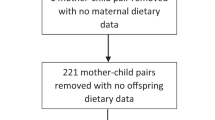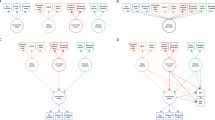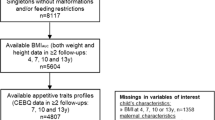Abstract
Introduction:
Low birth weight is associated with obesity and an increased risk for metabolic/cardiovascular diseases in later life.
Results:
The results of the snack delay test, which encompassed four distinct trials, indicated that the gender × intrauterine growth restriction (IUGR) × trial interaction was a predictor of the ability to delay the food reward (P = 0.002). Among children with normal birth weights, girls showed a greater ability to delay food rewards than did boys (P = 0.014).In contrast, among children with IUGR, there was no such differential ability between girls and boys. Furthermore, in girls, impulsive responding predicted both increased consumption of palatable fat (P = 0.007) and higher BMIs (P = 0.020) at 48 mo of age, although there was no such association with BMI at 36 mo.
Discussion:
In girls, the quality of fetal growth may contribute to impulsive eating, which may promote an increased intake of fats and consequently higher BMIs. As with the original thrifty phenotype, such a mechanism would be adaptive when food supplies are sparse, but would be problematic in societies with ample access to calorically rich foods.
Methods:
We examined whether the quality of intrauterine growth programs obesogenic eating behaviors, by investigating (i) the relationship between birth weight and impulsive eating in 3-year-old children (using the snack delay test), and (ii) whether impulsive eating predicts fat intake and/or BMI at 4 years of age (using a laboratory-based test meal).
Similar content being viewed by others
Log in or create a free account to read this content
Gain free access to this article, as well as selected content from this journal and more on nature.com
or
References
Forsén T, Eriksson J, Tuomilehto J, Reunanen A, Osmond C, Barker D . The fetal and childhood growth of persons who develop type 2 diabetes. Ann Intern Med 2000;133:176–82.
Ravelli AC, van der Meulen JH, Michels RP, et al. Glucose tolerance in adults after prenatal exposure to famine. Lancet 1998;351:173–7.
Law CM, Shiell AW, Newsome CA, et al. Fetal, infant, and childhood growth and adult blood pressure: a longitudinal study from birth to 22 years of age. Circulation 2002;105:1088–92.
Roseboom TJ, van der Meulen JH, Ravelli AC, et al. Blood pressure in adults after prenatal exposure to famine. J Hypertens 1999;17:325–30.
Barker DJ, Martyn CN, Osmond C, Hales CN, Fall CH . Growth in utero and serum cholesterol concentrations in adult life. BMJ 1993;307:1524–7.
Davies AA, Smith GD, Ben-Shlomo Y, Litchfield P . Low birth weight is associated with higher adult total cholesterol concentration in men: findings from an occupational cohort of 25,843 employees. Circulation 2004;110:1258–62.
Ravelli AC, van Der Meulen JH, Osmond C, Barker DJ, Bleker OP . Obesity at the age of 50 y in men and women exposed to famine prenatally. Am J Clin Nutr 1999;70:811–6.
Ravelli GP, Stein ZA, Susser MW . Obesity in young men after famine exposure in utero and early infancy. N Engl J Med 1976;295:349–53.
Pilgaard K, Hammershaimb Mosbech T, Grunnet L, et al. Differential nongenetic impact of birth weight versus third-trimester growth velocity on glucose metabolism and magnetic resonance imaging abdominal obesity in young healthy twins. J Clin Endocrinol Metab 2011;96:2835–43.
Bettiol H, Sabbag Filho D, Haeffner LS, et al. Do intrauterine growth restriction and overweight at primary school age increase the risk of elevated body mass index in young adults? Braz J Med Biol Res 2007;40:1237–43.
Forsén TJ, Eriksson JG, Osmond C, Barker DJ . The infant growth of boys who later develop coronary heart disease. Ann Med 2004;36:389–92.
Painter RC, de Rooij SR, Bossuyt PM, et al. Early onset of coronary artery disease after prenatal exposure to the Dutch famine. Am J Clin Nutr 2006;84:322–7; quiz 466–7.
Hales CN, Barker DJ . Type 2 (non-insulin-dependent) diabetes mellitus: the thrifty phenotype hypothesis. Diabetologia 1992;35:595–601.
Barbieri MA, Portella AK, Silveira PP, et al. Severe intrauterine growth restriction is associated with higher spontaneous carbohydrate intake in young women. Pediatr Res 2009;65:215–20.
Lussana F, Painter RC, Ocke MC, Buller HR, Bossuyt PM, Roseboom TJ . Prenatal exposure to the Dutch famine is associated with a preference for fatty foods and a more atherogenic lipid profile. Am J Clin Nutr 2008;88:1648–52.
Stein AD, Rundle A, Wada N, Goldbohm RA, Lumey LH . Associations of gestational exposure to famine with energy balance and macronutrient density of the diet at age 58 years differ according to the reference population used. J Nutr 2009;139:1555–61.
Gross LS, Li L, Ford ES, Liu S . Increased consumption of refined carbohydrates and the epidemic of type 2 diabetes in the United States: an ecologic assessment. Am J Clin Nutr 2004;79:774–9.
Oh K, Hu FB, Cho E, et al. Carbohydrate intake, glycemic index, glycemic load, and dietary fiber in relation to risk of stroke in women. Am J Epidemiol 2005;161:161–9.
Liu S, Willett WC, Stampfer MJ, et al. A prospective study of dietary glycemic load, carbohydrate intake, and risk of coronary heart disease in US women. Am J Clin Nutr 2000;71:1455–61.
Layman DK, Boileau RA, Erickson DJ, et al. A reduced ratio of dietary carbohydrate to protein improves body composition and blood lipid profiles during weight loss in adult women. J Nutr 2003;133:411–7.
Meaney MJ, Szyf M, Seckl JR . Epigenetic mechanisms of perinatal programming of hypothalamic-pituitary-adrenal function and health. Trends Mol Med 2007;13:269–77.
Levitt NS, Lambert EV, Woods D, Hales CN, Andrew R, Seckl JR . Impaired glucose tolerance and elevated blood pressure in low birth weight, nonobese, young south african adults: early programming of cortisol axis. J Clin Endocrinol Metab 2000;85:4611–8.
Plagemann A, Harder T, Brunn M, et al. Hypothalamic proopiomelanocortin promoter methylation becomes altered by early overfeeding: an epigenetic model of obesity and the metabolic syndrome. J Physiol (Lond) 2009;587(Pt 20):4963–76.
Diekhof EK, Gruber O . When desire collides with reason: functional interactions between anteroventral prefrontal cortex and nucleus accumbens underlie the human ability to resist impulsive desires. J Neurosci 2010;30:1488–93.
Dolan SL, Bechara A, Nathan PE . Executive dysfunction as a risk marker for substance abuse: the role of impulsive personality traits. Behav Sci Law 2008;26:799–822.
Leitner Y, Fattal-Valevski A, Geva R, et al. Neurodevelopmental outcome of children with intrauterine growth retardation: a longitudinal, 10-year prospective study. J Child Neurol 2007;22:580–7.
Geva R, Eshel R, Leitner Y, Fattal-Valevski A, Harel S . Memory functions of children born with asymmetric intrauterine growth restriction. Brain Res 2006;1117:186–94.
Franzek EJ, Sprangers N, Janssens AC, Van Duijn CM, Van De Wetering BJ . Prenatal exposure to the 1944-45 Dutch ‘hunger winter’ and addiction later in life. Addiction 2008;103:433–8.
Heinonen K, Räikkönen K, Pesonen AK, et al. Behavioural symptoms of attention deficit/hyperactivity disorder in preterm and term children born small and appropriate for gestational age: a longitudinal study. BMC Pediatr 2010;10:91.
Davis C . Attention-deficit/hyperactivity disorder: associations with overeating and obesity. Curr Psychiatry Rep 2010;12:389–95.
Liu Y, von Deneen KM, Kobeissy FH, Gold MS . Food addiction and obesity: evidence from bench to bedside. J Psychoactive Drugs 2010;42:133–45.
Dallman MF, Pecoraro N, Akana SF, et al. Chronic stress and obesity: a new view of “comfort food”. Proc Natl Acad Sci USA 2003;100:11696–701.
de Rooij SR, Painter RC, Phillips DI, et al. Cortisol responses to psychological stress in adults after prenatal exposure to the Dutch famine. Psychoneuroendocrinology 2006;31:1257–65.
de Rooij SR, Painter RC, Phillips DI, et al. Hypothalamic-pituitary-adrenal axis activity in adults who were prenatally exposed to the Dutch famine. Eur J Endocrinol 2006;155:153–60.
Kramer MS, Platt R, Yang H, McNamara H, Usher RH . Are all growth-restricted newborns created equal(ly)? Pediatrics 1999;103:599–602.
Kochanska G, Murray K, Jacques TY, Koenig AL, Vandegeest KA . Inhibitory control in young children and its role in emerging internalization. Child Dev 1996;67:490–507.
Golden M, Montare A, Bridger W . Verbal control of delay behavior in two year old boys as a function of social class. Child Dev 1977;48: 1107–1111.
Campbell SB, Szumowski EK, Ewing LJ, Gluck DS, Breaux AM . A multidimensional assessment of parent-identified behavior problem toddlers. J Abnorm Child Psychol 1982;10:569–91.
Vaughn BE, Kopp CB, Krakow JB . The emergence and consolidation of self-control from eighteen to thirty months of age: normative trends and individual differences. Child Dev 1984;55:990–1004.
Addessi E, Galloway AT, Visalberghi E, Birch LL . Specific social influences on the acceptance of novel foods in 2-5-year-old children. Appetite 2005;45:264–71.
Westerterp-Plantenga MS, IJedema MJ, Wijckmans-Duijsens NE . The role of macronutrient selection in determining patterns of food intake in obese and non-obese women. Eur J Clin Nutr 1996;50:580–91.
Zandstra EH, Mathey MF, Graaf C, van Staveren WA . Short-term regulation of food intake in children, young adults and the elderly. Eur J Clin Nutr 2000;54:239–46.
Vozzo R, Wittert G, Cocchiaro C, et al. Similar effects of foods high in protein, carbohydrate and fat on subsequent spontaneous food intake in healthy individuals. Appetite 2003;40:101–7.
Boudville A, Bruce DG . Lack of meal intake compensation following nutritional supplements in hospitalised elderly women. Br J Nutr 2005;93:879–84.
Zeger SL, Liang KY . Longitudinal data analysis for discrete and continuous outcomes. Biometrics 1986;42:121–30.
Liang K-Y, Zeger SL . Longitudinal data analysis using generalized linear models. Biometrika 1986;73:13–22.
Ballinger GA . Using generalized estimating equations for longitudinal data analysis. Organiz Res Met 2004;7:127–150.
Rothman L . Oh Canada! Too many children in poverty for too long.Paediatr Child Health 2007;12:661–665.
Author information
Authors and Affiliations
Consortia
Corresponding author
Rights and permissions
About this article
Cite this article
Silveira, P., Agranonik, M., Faras, H. et al. Preliminary evidence for an impulsivity-based thrifty eating phenotype. Pediatr Res 71, 293–298 (2012). https://doi.org/10.1038/pr.2011.39
Received:
Accepted:
Published:
Issue date:
DOI: https://doi.org/10.1038/pr.2011.39
This article is cited by
-
Omega-3 polygenic score protects against altered eating behavior in intrauterine growth-restricted children
Pediatric Research (2023)
-
Association of increased abdominal adiposity at birth with altered ventral caudate microstructure
International Journal of Obesity (2021)
-
The Association Between Birth Weight and Fat, Sugar, and Vegetable Consumption in a National Sample of U.S. Preschool Age Children
Maternal and Child Health Journal (2021)
-
Birth weight and catch up growth are associated with childhood impulsivity in two independent cohorts
Scientific Reports (2018)
-
The association of birth weight and postnatal growth with energy intake and eating behavior at 5 years of age – a birth cohort study
International Journal of Behavioral Nutrition and Physical Activity (2016)



